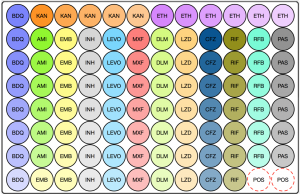CRyPTIC’s aim is to obtain a complete catalogue of resistance-conferring mutations that, ultimately, will facilitate design of near-to-patient amplification-based molecular DST and enable routine culture-based assays to be finally phased out, with a move towards a WGS workflow. Robust quantitative measures of phenotypes—minimal inhibitory concentrations—that allow for a refined understanding of precise contributions of different genomic variants to the degree of drug susceptibility are, therefore, crucial. Moreover, this change in paradigm likely represents a valuable opportunity to continue to use some drugs with low-level resistance in second- or third-line regimens (what, for example, is done with HIV treatment), something important when we are talking about first-line drugs.
The definition of an optimal plate design was a naturally iterative process that took approximately 1 year to complete and involved TB specialists all over the world. In a number of conference calls and meetings, CRyPTIC’s partners provided inputs both in terms of panel composition and drug concentration ranges. There was a real desire to contemplate needs coming from both clinical and research backgrounds; sadly, to fulfill this aspiration, 2 different plates would be necessary to accommodate all the drugs researchers and practitioners would love to have more information on.
After much deliberation, it was agreed to be in CRyPTIC’s best interests that we focused on one design that was as comprehensive as possible in a context of financial and logistical limitations. Eight different versions later, in May 2016, a final design including 14 of the most clinically relevant drugs (for example, those in the shorter MDR-TB regimen recommended by WHO, plus bedaquiline and delamanid), was handed over for Thermo Fisher to manufacture. Here is the final design, containing all the first-line drugs, including rifabutin but sadly excluding pyrazinamide (which that did not perform well in this assay due to its fiddly requirement of an acidic media to activate the prodrug), 2 quinolones (moxifloxacin and levofloxacin), 2 aminoglycosides (kanamycin and amikacin), some of the older and repurposed drugs (clofazimine, ethionamide, linezolid, PAS) and the youngsters bedaquiline and delamanid:

This plate will be validated by CRyPTIC’s collaborating institutions, and used in the first few thousands of samples originated in Peru, South Africa, Pakistan, central Asian countries, England and India. Initial results will determine if all drugs perform well, and if we have gotten the concentration ranges correctly, so that adjustments are made if necessary. I’ll talk about the validation study design on my next post.
ALGC

